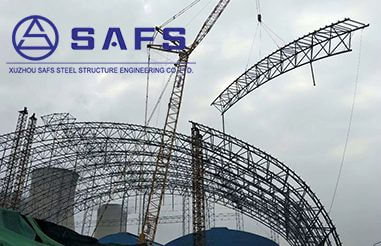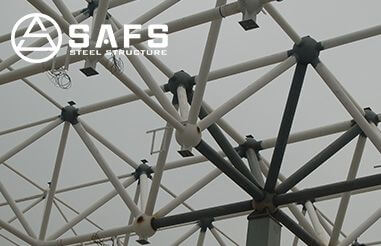Dapeng Town Industrial Park, Tongshan District, Xuzhou City, Jiangsu Province, China
(1) Tube truss
The tube truss is mainly composed of steel tube rods. These rods are connected by welding or bolts to form truss units. Their shapes can be flat, triangles, parallelograms, etc., or spatial. In a flat tube truss, each rod is basically in the same plane and connected by nodes to form a structure similar to a bridge or roof truss. The spatial tube truss is a more complex structure formed by combining multiple flat tube trusses or connecting them through special spatial rods, but its basic unit is still a flat truss.
The node structure of the tube truss is relatively simple, mainly including intersecting nodes (direct welding of rods) and bolt ball nodes. Intersecting nodes are steel tube rods cut at a certain angle and welded together. This node is simple in appearance, but has high requirements for welding technology; bolt ball nodes are rods connected to ball nodes by bolts, which is easy to install and disassemble and suitable for structures that need frequent adjustment or maintenance.

(2) Grid structure
Grid structure is a spatial bar structure, which is composed of a large number of bars intersecting in space to form numerous triangular or quadrilateral grids. These grids are closely connected to form a spatial whole. The bars of the grid are arranged in a relatively regular and uniform manner, without obvious primary and secondary distinctions like the tube truss. All bars work together to bear the load.
The node forms of the grid mainly include bolt ball nodes and welded ball nodes. The bolt ball node connects the bar to the ball node through high-strength bolts. This node is easy to install and has high precision requirements; the welded ball node welds the bar to the hollow ball. Its bearing capacity is relatively high, but the welding workload is large and the welding quality requirements are more stringent.
(1) Tube truss
The plane tube truss is mainly subjected to forces in the plane. Its stress characteristics are that the upper chord is usually compressed, the lower chord is tensile, and the web transmits internal forces according to its position and angle. When bearing vertical load, the load is transmitted to the supports on both sides through the upper chord, and the lower chord balances the pressure of the upper chord by stretching. For the spatial tube truss, although it can bear load in space, its internal force transmission path is relatively clear, mainly along the direction of the plane truss unit, and the overall spatial force performance is not as good as the grid structure.
(2) Grid structure
Due to its spatial grid system, the grid structure has excellent spatial force performance. When subjected to load, the load can be transmitted to each node and support through the rods from multiple directions, making the internal force distribution more uniform and effectively avoiding stress concentration. In terms of resisting lateral forces (such as wind loads and seismic loads), the grid structure can use its spatial stiffness to form an overall lateral force resistance system, greatly reducing the lateral deformation of the structure, which is an advantage that the tube truss structure (especially the plane tube truss) does not have.

(1) Tube truss
The tube truss is widely used in industrial plant roof trusses, bridge structures and other fields. In industrial plants, tube trusses can be used as roof truss systems, using their efficient plane force performance to carry roof loads and crane loads. In terms of bridges, tube trusses can be used as the main bridge structure, and the span and bearing capacity requirements of the bridge can be met through reasonable design and layout. In addition, in some occasions with special requirements for architectural shape, such as the local shape structure of exhibition halls and stadiums or some landscape buildings, tube trusses can also play their unique advantages and achieve complex architectural shapes through ingenious design.
(2) Grid structure
Grid structure is mainly suitable for large-span building roofs, such as large stadiums, exhibition halls, airport terminals, etc. These buildings require a large column-free space, and the large span advantage of the grid structure can well meet this requirement. At the same time, the grid structure can realize various complex curved surface shapes according to the requirements of architectural design, providing the building with a good spatial vision and a unique architectural appearance.